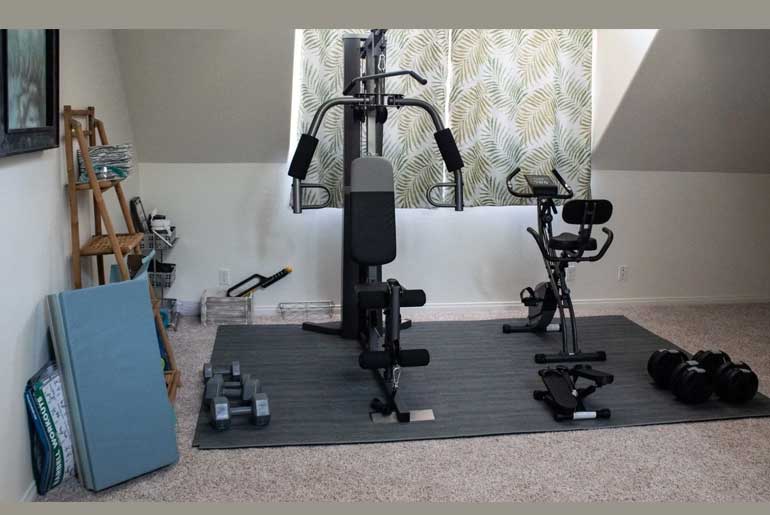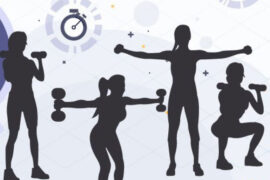Home gym equipment refers to various fitness tools and machines that individuals can use to exercise and stay fit within the comfort of their own homes. Having a home gym allows individuals to have the convenience of working out at any time, without the need to travel to a fitness facility. The popularity of home gyms has increased, especially with the rise of online fitness resources and the desire for flexible workout options.
Setting up a home gym provides the flexibility to work out on your schedule, avoid crowded fitness facilities, and create a comfortable and motivating exercise environment. Whether you have a dedicated room for your gym or a small space in your living area, there are various options to create an effective and enjoyable home workout space.
Top 10 must-have home gym equipment options for creating an ultimate fitness setup:
-
Power Rack or Squat Rack:
The terms “Power Rack” and “Squat Rack” are often used interchangeably, but there are some differences between the two. Both are essential pieces of equipment for strength training, particularly for barbell exercises. Let’s explore the distinctions:
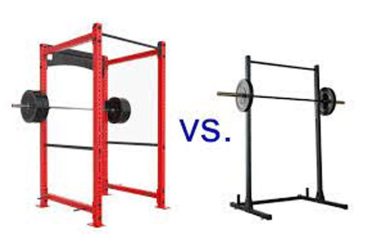
Power Rack:
- Also known as a power cage or power station, a power rack is a large, four-posted metal frame.
- It has safety pins or bars attached to the posts, allowing for adjustments in height to catch the barbell if you fail to complete a lift.
- Power racks are versatile and offer a wide range of exercises, including squats, bench presses, overhead presses, pull-ups, and more.
- The safety features make it a preferred choice for heavy lifting and exercises where failure could be dangerous.
- Power racks are generally larger and take up more space, making them suitable for dedicated home gym setups.
Squat Rack:
- A squat rack is a more compact version of a power rack, often consisting of two upright posts and a connecting bar at the top.
- Unlike a power rack, a squat rack doesn’t have safety pins or bars for fail-safe protection.
- It is primarily designed for squats and sometimes used for overhead presses.
- Squat racks are suitable for individuals who prioritize squatting and have limited space or budget for their home gym.
In summary, both the power rack and squat rack are valuable additions to a home gym for strength training. The choice between them depends on factors such as available space, budget, and the variety of exercises you wish to perform. If you prioritize safety and want more exercise options, a power rack is a better choice. If space is limited and squats are your main focus, a squat rack can suffice.
-
Barbell and Weight Plates:
A barbell and weight plates are essential pieces of equipment for strength training and are commonly used in various exercises to build muscle and increase strength. Let’s take a closer look at each:
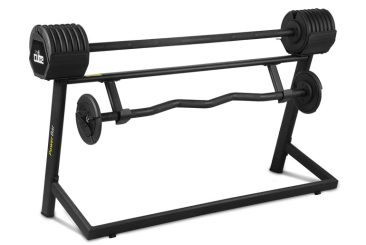
Barbell:
- A barbell is a long, straight bar made of metal and usually weighing around 45 pounds (20 kilograms). There are also lighter barbells available for beginners or specific training purposes.
- It is designed to hold weight plates on each end, allowing for variable resistance during exercises.
- Barbells come with various types of knurling (the textured pattern on the bar) to provide a secure grip during lifting.
- They are used for compound exercises like squats, deadlifts, bench presses, overhead presses, rows, and more.
Weight Plates:
- Weight plates are circular discs made of metal and come in different sizes and weights, typically ranging from 2.5 pounds (1.25 kilograms) to 45 pounds (20 kilograms) or more.
- They are placed on the ends of the barbell to add resistance and vary the intensity of exercises.
- Weight plates are available in both standard and Olympic sizes. Standard plates have a 1-inch hole diameter and are usually found in home gym setups, while Olympic plates have a 2-inch hole diameter and are used in commercial gyms and professional weightlifting competitions.
Combining a barbell with weight plates allows for a wide range of exercises and provides progressive overload, a fundamental principle of strength training. This setup enables individuals to gradually increase the resistance as they get stronger, promoting muscle growth and improved overall strength. Both barbells and weight plates are foundational components of any home or commercial gym, serving as the backbone for strength-based workouts.
-
Adjustable Dumbbells:
Adjustable dumbbells are a versatile and space-efficient piece of strength training equipment that allow you to adjust the weight according to your workout needs. Unlike traditional dumbbells, which come in fixed weights, adjustable dumbbells offer a range of weight options within a single set, making them an excellent choice for home gyms or limited spaces.
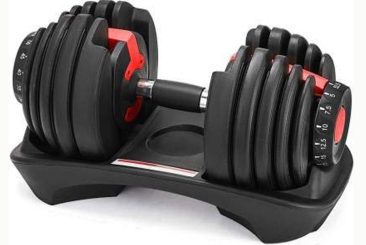
Here’s how adjustable dumbbells typically work:
Design:
- Adjustable dumbbells consist of a handle or grip, and weight plates that can be easily added or removed.
- The handle serves as the core, and weight plates can be secured to the handle with various mechanisms, such as a clamp, dial, or pin.
Adjusting Weight:
- To change the weight, you simply add or remove weight plates from each end of the dumbbell handle.
- Some adjustable dumbbells come with quick-adjustment mechanisms, allowing you to change the weight rapidly with the turn of a dial or a selector pin.
Benefits:
-
- Space-Efficient: A single set of adjustable dumbbells can replace multiple traditional dumbbells, saving space in your home gym.
- Versatility: With the ability to adjust the weight, you can perform a wide variety of exercises, targeting different muscle groups at various intensity levels.
- Progression: As you get stronger, you can increase the weight by adding more plates, promoting continuous muscle growth and strength gains.
Overall, adjustable dumbbells are a fantastic investment for home workouts, allowing you to perform strength exercises with ease and convenience. They are suitable for both beginners and advanced fitness enthusiasts, offering a cost-effective and space-saving solution for strength training.
-
Bench:
A bench is a fundamental piece of equipment for strength training and is commonly used in a variety of exercises to target different muscle groups. Weight benches come in different shapes and designs, but they all serve as a stable platform for various exercises. Here’s what you need to know about benches:
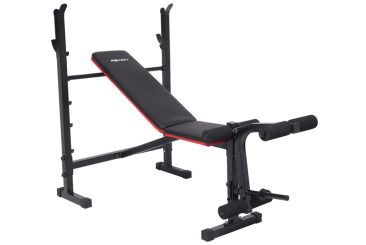
Types of Benches:
- Flat Bench: A basic, flat surface that provides support for exercises like bench press, dumbbell presses, and various bodyweight movements.
- Adjustable Bench: This type of bench can be adjusted to different angles, such as incline, decline, or flat positions. It allows for a greater variety of exercises, targeting various angles of the chest, shoulders, and arms.
- Utility Bench: A versatile bench that often comes with additional attachments or features, such as leg curl and leg extension attachments. It allows for a wider range of exercises, including targeting the lower body.
Benefits of a Bench:
- Versatility: A weight bench opens up a range of exercises that target different muscle groups, especially the chest, shoulders, and arms.
- Stability: When performing exercises like bench press, having a stable surface ensures safety and proper form.
- Progression: As you get stronger, a weight bench allows you to gradually increase the weight lifted, promoting muscle growth and strength gains.
Exercises Using a Bench:
- Bench Press (flat, incline, decline)
- Dumbbell Presses (flat, incline, decline)
- Dips
- Bulgarian Split Squats
- Step-ups
- Seated Shoulder Press
- Tricep Dips
A weight bench is a valuable addition to any home gym and pairs well with barbells, dumbbells, and other strength training equipment. When choosing a bench, consider factors such as stability, adjustability, weight capacity, and the exercises you intend to perform. Remember to prioritize safety and proper form during your workouts.
-
Cardio Machine (Treadmill, Stationary Bike, or Rowing Machine):
A cardio machine, also known as cardiovascular or aerobic exercise equipment, is designed to provide effective cardiovascular workouts that elevate your heart rate and improve your overall cardiovascular fitness. These machines offer low-impact and high-impact options to suit different fitness levels and preferences. Here are some popular types of cardio machines:
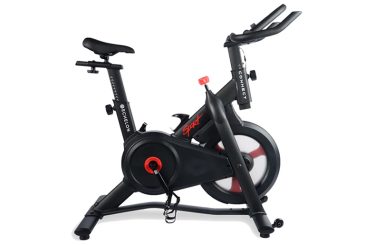
- Treadmill: A motorized machine with a moving belt that allows you to walk, jog, or run in place. Treadmills offer adjustable speed and incline settings for a challenging workout.
- Stationary Bike: Available in two main types: upright and recumbent. Upright bikes mimic traditional bikes, while recumbent bikes have a more comfortable, reclined seat. Both provide excellent lower body workouts.
- Elliptical Trainer: Combines the movements of running, stair climbing, and cross-country skiing. It offers a low-impact full-body workout.
- Rowing Machine: Also known as a rower or ergometer, this machine simulates the motion of rowing a boat. It engages both upper and lower body muscles, providing an effective full-body workout.
- Stair Climber or Step Mill: Replicates the motion of climbing stairs. It engages the lower body and is excellent for toning the legs and glutes.
- Arc Trainer: Similar to an elliptical, but with a unique motion that reduces stress on the knees and hips.
- Air Bike: A stationary bike with moving handles, providing both upper and lower body workouts. The resistance increases as you pedal and push/pull the handles.
- Jump Rope: Although not a traditional machine, a jump rope is an effective and affordable way to perform cardiovascular exercise.
Benefits of Cardio Machines:
- Improve cardiovascular health and endurance.
- Burn calories and aid in weight management.
- Low-impact options for individuals with joint issues or injuries.
- Convenient for indoor workouts, especially in unfavorable weather conditions.
- Some machines offer additional features like heart rate monitoring and preset workout programs.
When choosing a cardio machine, consider your fitness goals, current fitness level, available space, and any physical limitations you may have. It’s essential to use proper form and follow safety guidelines to get the most out of your cardio workouts and prevent injuries.
-
Pull-Up Bar or Pull-Up/Dip Station:
A pull-up bar and a pull-up/dip station are both excellent pieces of equipment for upper body strength training, particularly targeting the muscles in your back, shoulders, and arms. Let’s take a closer look at each:
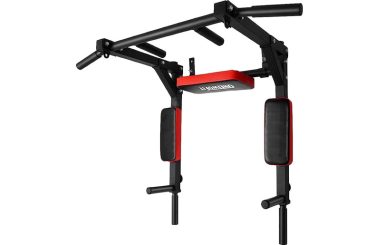
Pull-Up Bar:
- A pull-up bar is a simple and compact piece of equipment that attaches to a doorway or wall.
- It allows you to perform pull-ups, chin-ups, and hanging leg raises, primarily focusing on the muscles in your upper back, biceps, and core.
- Pull-up bars are a cost-effective option and take up minimal space, making them suitable for home gyms with limited room.
- They are available in different styles, including doorway-mounted bars with no need for drilling, and wall-mounted bars for a more permanent setup.
Pull-Up/Dip Station:
- A pull-up/dip station is a more versatile piece of equipment that includes a pull-up bar as well as parallel bars for dips.
- It allows you to perform not only pull-ups and chin-ups but also dips, targeting the muscles in your chest, triceps, and shoulders.
- Pull-up/dip stations often have a sturdier and freestanding design, providing more stability and allowing for a wider range of exercises.
- Some models may include additional features, like push-up handles or leg raise stations, adding even more exercise options.
Choosing Between the Two:
- If you are primarily interested in pull-ups and have limited space or budget, a pull-up bar that fits in a doorway can be a practical choice.
- If you want a more comprehensive upper body workout and have the space for a larger piece of equipment, a pull-up/dip station offers the advantage of targeting multiple muscle groups with a single setup.
Ultimately, both a pull-up bar and a pull-up/dip station are valuable additions to a home gym, providing opportunities for bodyweight exercises that build strength and tone various upper body muscles. Consider your fitness goals, available space, and budget when deciding which one is best suited for your needs.
-
Kettlebells:
Kettlebells are a versatile and effective piece of fitness equipment used for strength training, conditioning, and functional exercises. They have a distinctive shape, resembling a cannonball with a handle, which allows for a wide range of dynamic movements. Kettlebells are available in various weights, making them suitable for people of different fitness levels. Here are some key points about kettlebells:
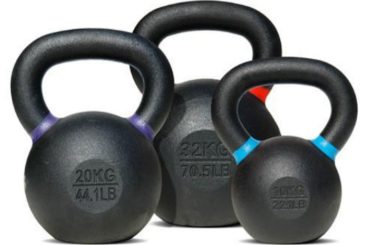
Design:
- Kettlebells come in different weights, typically ranging from a few pounds to over 100 pounds.
- They are made of cast iron or other durable materials and have a handle that allows for a comfortable grip.
- The unique design of kettlebells makes them ideal for exercises that involve swinging, lifting, and dynamic movements.
Benefits:
- Strength Training: Kettlebell exercises target various muscle groups, including the core, legs, back, shoulders, and arms, promoting strength and muscle development.
- Cardiovascular Conditioning: Kettlebell workouts can also provide an intense cardiovascular workout, helping improve endurance and burn calories.
- Functional Fitness: Kettlebell exercises often involve multi-joint movements and mimic real-life activities, improving overall functional fitness.
- Versatility: Kettlebells can be used for a wide variety of exercises, such as swings, cleans, snatches, presses, squats, lunges, and more.
Popular Kettlebell Exercises:
- Kettlebell Swing
- Turkish Get-Up
- Kettlebell Clean and Press
- Goblet Squat
- Kettlebell Snatch
- Kettlebell Row
Home Gym Use:
- Kettlebells are an excellent addition to a home gym due to their compact size and versatility.
- They can replace traditional dumbbells and barbells for many exercises, saving space and cost.
When using kettlebells, it’s essential to learn proper form and technique, as many exercises involve dynamic movements and may put strain on your body if done incorrectly. Beginners should start with lighter weights and gradually progress as their strength and technique improve. Consulting a fitness professional or trainer can be beneficial, especially if you’re new to kettlebell training.
-
Resistance Bands:
Resistance bands are a popular and versatile piece of fitness equipment used for strength training, flexibility exercises, and rehabilitation. These bands are made of elastic materials and come in various shapes, sizes, and resistance levels. They offer a wide range of benefits and are suitable for individuals of all fitness levels. Here are some key points about resistance bands:
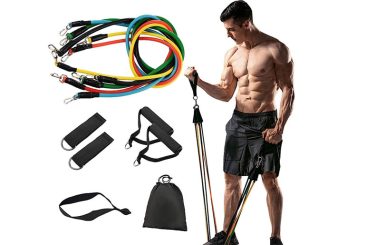
Types of Resistance Bands:
- Loop Bands: These bands form a continuous loop and are commonly used for lower body exercises like squats, lunges, and glute bridges.
- Tube Bands with Handles: These bands have handles at each end and can be used for upper body exercises like bicep curls, shoulder presses, and rows.
- Flat Bands: These are long, flat bands without handles, and they can be used for various exercises, including stretching and mobility work.
Resistance Levels:
- Resistance bands come in different levels of resistance, usually color-coded to indicate their strength. Common levels include light, medium, heavy, and extra-heavy resistance.
- Beginners can start with lighter bands and gradually progress to higher resistance levels as they get stronger.
Benefits of Resistance Bands:
- Versatility: Resistance bands can target all major muscle groups and provide a full-body workout. They can be used for strength training, stretching, and rehabilitation exercises.
- Portability: Resistance bands are lightweight and compact, making them perfect for travel or home workouts when space is limited.
- Joint-Friendly: Bands provide a variable resistance that reduces the strain on joints, making them suitable for people with joint issues or those in the process of rehabilitation.
- Progressive Overload: Resistance bands allow for progressive resistance, as you can easily adjust the tension by using different bands or changing your body positioning.
Exercises Using Resistance Bands:
- Bicep curls
- Shoulder presses
- Chest flies
- Leg curls
- Glute bridges
- Clamshells
- Pull-aparts
- External rotations
Resistance bands are a valuable addition to any fitness routine and can complement other types of equipment. They are affordable, accessible, and effective tools for improving strength, flexibility, and overall fitness. As with any exercise, it’s essential to maintain proper form and gradually increase resistance as your strength improves.
-
Medicine Balls:
Medicine balls are a versatile and effective piece of fitness equipment used for strength training, core workouts, and functional exercises. They are weighted balls that come in various sizes, weights, and materials. Medicine balls are designed to be held and used for dynamic movements, making them ideal for a wide range of exercises. Here are some key points about medicine balls:
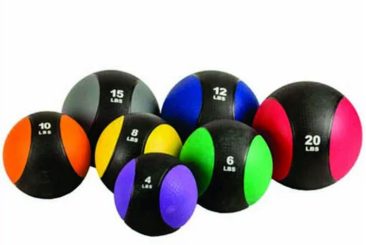
Design:
- Medicine balls are typically made of rubber, leather, or synthetic materials.
- They come in different weights, usually ranging from 2 pounds to over 20 pounds, allowing for progressive resistance.
- Some medicine balls are designed with handles for a more secure grip during exercises.
Benefits:
- Strength Training: Medicine balls are effective for building strength in various muscle groups, including the core, upper body, and lower body.
- Core Workouts: Many medicine ball exercises involve rotational and twisting movements, making them excellent for core training and stability.
- Functional Fitness: Medicine balls can simulate real-life movements, enhancing functional fitness and improving athletic performance.
- Coordination and Balance: Exercises with medicine balls often require coordination and balance, leading to improved motor skills.
Popular Medicine Ball Exercises:
- Medicine Ball Slams
- Russian Twists
- Wall Throws
- Woodchoppers
- Medicine Ball Push-Ups
- Lunge with Twist
- Squat to Overhead Press
Home Gym Use:
- Medicine balls are a valuable addition to a home gym due to their versatility and space efficiency.
- They can be used for both strength and cardiovascular workouts, offering a dynamic range of exercises.
Safety Considerations:
- When using medicine balls, be mindful of your form and start with a weight that you can handle safely.
- Avoid bouncing the ball off hard surfaces, as it may cause injury or damage to the ball.
- Always warm up before performing medicine ball exercises, and listen to your body to prevent overexertion.
Medicine balls are suitable for individuals of various fitness levels, and their versatility makes them a valuable tool for achieving overall strength, power, and coordination. Including medicine ball exercises in your workout routine can add variety and challenge, leading to well-rounded fitness benefits.
-
Yoga Mat and Foam Roller:
Yoga Mat: A yoga mat is a must-have accessory for practicing yoga and various other floor-based exercises. It provides a comfortable and supportive surface for your workouts and helps prevent slipping during poses. Here are some key features and benefits of a yoga mat:
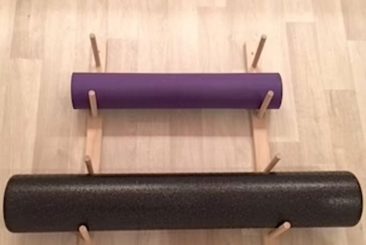
- Cushioning: A yoga mat offers cushioning to protect your joints and provide a comfortable surface for yoga, pilates, stretching, and bodyweight exercises.
- Traction: The textured surface of a yoga mat prevents your hands and feet from slipping during poses, allowing you to maintain stability and proper alignment.
- Portability: Most yoga mats are lightweight and come with straps or carry bags, making them easy to carry to the gym, studio, or outdoor workouts.
- Hygiene: Using your own yoga mat ensures you have a clean and personal surface for your practice, especially in shared workout spaces.
- Variety: Yoga mats are available in different thicknesses, materials, and designs to suit various preferences and exercise styles.
Foam Roller: A foam roller is a cylindrical foam-based exercise tool used for self-massage and myofascial release. It helps release tension in muscles, improve flexibility, and enhance muscle recovery. Here are the benefits and uses of a foam roller:
- Myofascial Release: Foam rolling applies pressure to trigger points and tight areas in your muscles, promoting myofascial release and reducing muscle knots and adhesions.
- Improved Flexibility: Regular foam rolling can help improve flexibility and range of motion by breaking down muscle tightness.
- Muscle Recovery: Foam rolling after a workout can aid in muscle recovery by increasing blood flow and reducing post-exercise soreness.
- Injury Prevention: Using a foam roller can help prevent injuries by addressing muscle imbalances and tightness that may lead to overuse injuries.
- Versatility: Foam rollers can be used on various muscle groups, including the back, legs, hips, and shoulders, providing a full-body recovery tool.
Both a yoga mat and a foam roller are valuable additions to any fitness routine. The yoga mat enhances comfort and stability during floor-based exercises, while the foam roller supports muscle recovery and flexibility. These two tools are suitable for people of all fitness levels and can be used at home, in the gym, or during outdoor workouts.
With this equipment, you’ll have a comprehensive setup for strength training, cardio workouts, and flexibility training. Always prioritize safety, proper form, and progression in your home workouts. Customize your home gym based on your fitness goals and interests, and remember to make the space inviting and motivational to keep you motivated on your fitness journey.
Disclaimer:
The information contained in this article is for educational and informational purposes only and is not intended as a health advice. We would ask you to consult a qualified professional or medical expert to gain additional knowledge before you choose to consume any product or perform any exercise.

